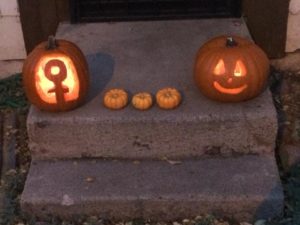 What used to scare me: the flying monkeys in The Wizard of Oz, that part in Raiders of the Lost Ark where the Nazi’s face melted off, escalators at the Woodfield Mall.
What used to scare me: the flying monkeys in The Wizard of Oz, that part in Raiders of the Lost Ark where the Nazi’s face melted off, escalators at the Woodfield Mall.
These days, I’m scared by far more terrifying, albeit everyday, forces, but I do like Halloween, arriving precisely when hoodies and extra blankets are warranted.
My students are passionate about Halloween. Middle schoolers laugh about the people who keep their lights off “but the television is obviously still on” and about “gross candy” and “the lady who gives out toothbrushes.” When they talk about trading candy with their siblings, I remember doing the same with my brother and feel a tinge of nostalgia, wondering what year it was we last sat in the living room and swapped a Reese’s for a Milky Way. Freshmen bemoan the fact that some neighbors accuse them of being “too old to trick-or-treat.”
When I was a senior in high school, well past my trick-or-treating expiration date, some of my male friends proposed that our friend group pay a visit to the Gacy House. As in, we should go to the house where John Wayne Gacy lived, tortured, murdered and buried dozens of teenagers and young men.
I found the idea preposterous, appalling and yet absolutely enthralling. Here we were, living in the Midwest, where you couldn’t swing a black cat without hitting a serial killer, and yet we’d never really taken full advantage of our proximity to the many mass-murder attractions our region had to offer.
My friends and I were toddlers when, in a suburban town near ours, Gacy was arrested and convicted. We’d grown up in the shadow of his monstrous crimes. There was always someone who knew a guy who had a cousin who was married to someone who was somehow connected to Gacy himself or one of his victims. Sometimes the connections proved true; more often, the slightest probing proved them false.
So on Halloween, my senior year, late at night, I and a group of my closest friends drove to Summerdale Avenue and entered the house. We clutched each other and screamed as we made our way through rooms unlit but for a weak flashlight carried by one of the boys.
I don’t remember a great deal about the interior of the home fixated, though I was, on appearing stoic for the benefit of a girl on whom I had a crush. I do remember that after our adventure we went to Denny’s, chain smoked cigarettes, drank bottomless coffee, breathless and high on the adrenaline of our audacity, proud of our courage, which had manifested in cowering and dreadful howling.
When I was in my early 30s, I learned that Gacy’s house had been razed in the ‘70s, shortly after the 29 bodies were exhumed. Given that my visit took place in the early ‘90s, what my friends and I had actually done was break-and-enter an empty, perfectly nice, ranch-style home in the suburbs of Chicago, creep slowly from room to room and shriek.
When I discovered I had never been in the Gacy house, I felt simultaneously relieved and guilty—guilty for contaminating the future homeowner’s domicile with our fear. Nevertheless, “teenagers were once afraid, for no reason, in this house” probably doesn’t diminish property value.
In Ministry’s classic “Every Day is Halloween,” Al Jourgensen laments, “Why can’t they see they’re just like me?” To my knowledge, he’s not lamenting an inability to dress like Nosferatu on a job interview, but celebrating his misfit status and imploring others to celebrate with him. In high school, my friends and I fancied ourselves exactly the people Jourgensen was singing about–we expressed disdain for all that was conventional, all that was mainstream (even if it was good). We, you know, “heard of that band before you did.”
Our entire burgeoning identities were all wrapped up in “otherness.” Even our visit to the not-Gacy-house was about being different, about doing something no one else would think of or dare to do.
Though Halloween is rooted in ancient traditions like the Celts’ Samhain, present-day Halloween traditions, even for adults, have precious little to do with the living and the dead commiserating and everything to do with asserting eccentricities, with reveling in our deeply absurd peculiarities, with testing limits.
Halloween has more to do with “otherness” than it does with existential dread, and really, I’m glad of that. (February, frankly, is a far more opportune month in which to collectively and soberly contemplate mortality.)
You don’t have to be a ghost or ghoul. You don’t even have to visit a serial killer’s house—actually, I’d strongly advise against that.
You can poorly carve a pumpkin and feel fairly good about it until you see an Instagram post by your friend who carved a very realistic looking raven into his pumpkin; you can eat pumpkin seeds you burnt while watching Children of the Corn or Carrie and feeling old because the films are so familiar they’re more comforting than scary; and you can ask kids the question that (according to my students) is the most annoying: “What are you supposed to be?”
You can do nothing but bask in the changing temperatures, the fiercely gorgeous red-orange leaves patterning the ground and clinging to the trees. You can reminisce about dead-serious candy trade negotiations that took place in your parents’ living room. You can take note of the early sunset, the need for another blanket, and think about how our ancestors tried to make sense of the change through stories that, perceptively, concluded that somewhere around the end of October the barrier between life and death, between the ordinary and extraordinary, grows precipitously thin.

